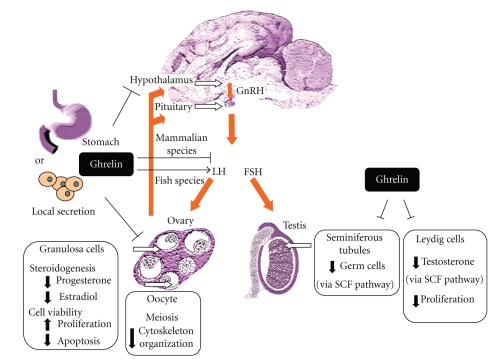Figure 1.
Schematic representation of the ghrelin effects at the level of the hypothalamic-pituitary-gonadal axis. Ghrelin, mainly produced by the stomach, can act through its functional receptor GHS-R1a in endocrine or/and local manner in all male and female reproductive tissues including hypothalamus, pituitary, ovary, and testis. It is well known that ovarian steroid production (oestradiol and progesterone) can modulate pituitary and hypothalamus secretions. Furthermore, GnRH produced by the hypothalamus controls LH, and FSH secretion that is known to regulate gonad functions. In mammalian species, ghrelin treatment inhibits GnRH, LH and FSH secretion at the hypothalamic and pituitary levels (red arrows). Opposite effects have been described in several species of fish. In the gonads, ghrelin exerts also inhibitory effects by altering steroidogenesis and germ cells production or viability in ovary and testis. In contrast, ghrelin treatment reduces proliferation of Leydig cells whereas it increases those of granulosa cells. SCF pathway: Stem Cell Factor pathway. ↓: decrease, ↑: increase, and ⊥: inhibition.

